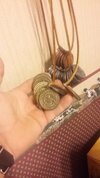coondogger
Member
- Joined
- Aug 18, 2009
- Messages
- 552
I'm using Hogdon Pyrodex.I'm just curious if you are using a BP substitute like pyrodex?
I'm using Hogdon Pyrodex.I'm just curious if you are using a BP substitute like pyrodex?
BINGO!! SHAZAM! Give the man a cigar. DO NOT use hot water. Nyet! NINE!!! Luke-warm at most. Hot water will cause "flash rust". It evaporates too fast. I've not read through to the end of this thread, but I can't believe this has not been mentioned.I tried the extremely hot soapy water method on a black powder firearm once and rust formed instantly--even though the hot water dried very quickly. The water disappeared almost immediately but the rust formed even faster. There were tiny rust spots anywhere the water had made contact, on the blued finish, inside the bore--everywhere. You could see the rust spots and feel them and they weren't the kind that brush off easily. It was a real mess. Maybe it works ok in dry environments--I don't really know. I know I won't use that method again.
I think pyrodex is more corrosive than real black.
Urine was commonly used. We've all heard about using it in combat, when there was no water, but that wasn't the only time. 98.6 degrees, just right. "Don't pee down my barrel, and tell me it's raining."I do use hot water but not so hot I can't put my hands in it. Indians used to clean their rifles in creeks. Wood and all.
Urine was commonly used. We've all heard about using it in combat, when there was no water, but that wasn't the only time. 98.6 degrees, just right. "Don't pee down my barrel, and tell me it's raining."
Yes, creeks, rain barrel, pond or lake, cold water was the go to. I've found Windex glass cleaner to be my go-to. That's all I use. (the exception being the TC, that I remove the barrel, put it in the sink, and pump warm (about 98.6!!!) soapy water through it. Mostly because I don't trust that long weird flash channel)
Bottom line, cold water evaporates very slowly, giving one time to dry the bore and oil it long before any rusting can occur, let alone flash-rust. Some guys use boiling water, and wonder why they get instant rust.I don't believe warm, hot or boiling cleans any better than cold. Maybe, perhaps warm. A little dish soap is what really makes the difference.
Perzactly !!It's funny, I live in Mississippi and if it's anything here it's humid. I use hot soapy water and I don't get any flash rust. I do use WD-40 after the soapy water but with my revolvers I set the action aside to drain while I clean the rest. Then do all the parts with WD at once.

And here's the problem. While some swear it won't harm a barrel, have never had an issue, leave guns for days without cleaning or rust, my experience with this stuff is the exact, 180degree opposite. Most of the seriously roached guns and ruined barrels I've seen are ones that have been shot with Pyrodex. I won't use it or recommend it to anyone. I go through quite a bit of the holy black every year, and I'm not talking a couple pounds. It's on the order of 40-50lbs a year. I use the holy black in competition shooting, practice, recreational plinking, and in teaching muzzleloading. I have been forced to leave a gun uncleaned for more than a couple days on occasion and in every case with real black powder, there was no issue.I'm using Hogdon Pyrodex.

It is! The Pyrodex formulation uses perchlorates, a salt of perchloric acid, which is used as a powerful oxidizing agent in modern pyrotechnics, but it is highly corrosive and a tough to kill salt/acid! It is a stronger acid than either sulfuric acid, nitric acid or hydrochloric acid!I think pyrodex is more corrosive than real black.
It certainly has it's place! We're not saying "Don't use it ... ", but to just clean the arm up really well afterwards! A friend, who would have to travel across 3 State lines to get real BP, uses it successfully with duplex loads. Like 10-grains of real 3Fg BP down in the bore 1st in his flintlock, then Pyrodex to fill the load above it.Where it comes to Pyrodex let your own experience guide you. Not what somebody on an internet forum tells you but give it an honest chance and not go off of what others say.
anyways - ballistol emulsion is the best method cleaning up after black powder. Simple, easy, less time and less messy and less hassle than all other methods described here. My 133 yr old TD with major pitting shoots great and no rust. I don't shoot BP substitutes but those I've talked to say it is fine if you clean it immediately after your session. I clean my BP rifles immediately upon returning home but I know you can leave them for awhile if you are not in a super humid climate. Lee Shaver, international champion in muzzleloading talked about this in his magazine several issues back.


Seems like what you had there was proof that although a flintlock rifle is almost a fool proof system, a fool will work very hard to defeat it. If he’d used Blackpowder I suspect he would have found a way to screw it up as well.It is! The Pyrodex formulation uses perchlorates, a salt of perchloric acid, which is used as a powerful oxidizing agent in modern pyrotechnics, but it is highly corrosive and a tough to kill salt/acid! It is a stronger acid than either sulfuric acid, nitric acid or hydrochloric acid!
My experience confirms this too~! I buy out estates for anything BP and MZL-related and consult to 6 modern 'toy shops' near me, they call me for anything BP ... as they don't know them nor really want them. So I help go through them and it makes it a 'win - win' situation for all of us, and we might go through 30 to 50 BP arms a year. EVERY Pyrodex-suspected arm (mostly a Traditions or CVA, sometime a kit T/C) has significantly worse corrosion and pitting then even originals arms using real BP that date back to the 1800s, e.g., Springfield 1816 flintlocks, their later rifled muskets etc. and so on.
Off-topic, but on one flintlock ... I pulled not 1, not 2, but 3 loads from the barrel! The load was 2 stacked 50-grain 'power pellets' under a plastic saboted 44Mag handgun bullet, with another saboted charge above that, and on top of that was 80-grains of Pyrodex under a patched bore-butter ball! I suspect the shooter started out with the loose powdah/patched RB load then switched over to saboted loads, likely on the bad advice from a friend. When the power pellet load wouldn't fire, the loaded it up AGAIN and tried again. Wen that didn't fire ... they added the loose powdah load. Conditions showed the gun had been fired before they started this fiasco, as the breech area was rusted from combustion by-products of the Pyrodex firing, then sitting there for years. it is also more hydroscopic than real black powdah.
I’m a firm believer in load development, whether it be on my black powdah arms or those modern arms using smokeless. So by default, that would have to include any of the synthetic powders.WRT the fine accuracy you’re all showing us, do you think such accuracy is only possible with Black Powder?


